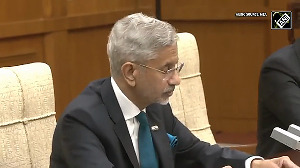Nanotechnology is the new frontier of scientific research. President APJ Abdul Kalam is advocating new initiative on the research in the field of nanotechnology. As Prof. CNR Rao, chairman of the Scientific Advisory Committee to the Prime Minister, said recently: 'We missed the semiconductor revolution in the early 1950s. We had just gained independence. But with nanoscience and technology, we can certainly be on an equal footing with the rest of the world.'
In its December 2006 issue, the Scientific American magazine published a list of 2006 Scientific American top 50 awards. The award lists the top 50 people in the field of research, business and policy making, who have influenced the world.
Pulickel Madhavapanicker Ajayan, the Henri Burlage Professor of Engineering at Rensselaer Polytechnic Institute (Research), Troy, New York, is among this list of top 50.
He graduated in metallurgical engineering in 1985 from the Institute of Technology, Banaras Hindu University (IT-BHU), Varanasi.
He has worked under the world-renowned Japanese nanoscientist, Dr Sumio Iijima. He was cited by Scientific American magazine for his pioneering research in using nanotubes to create super-resilient springs.
rediff.com guest columnist Yogesh K Upadhyaya talks with Prof Ajayan to find out more about nanotechnology.
Welcome. Please explain nanotechnology in brief to us.
Nanotechnology will be one of the most significant enabling technologies in the future. It will cover materials, devices, biotechnology and more. Nanoscience and nanotechnology are based on the length scale 'nano,' which is a billionth of a meter. In that sense it differs from other major technology areas such as information technology and biotechnology, which are based on broadly defined functions.
It is curious that this length scale 'nano' has become so important. The single most important reason is perhaps our incessant need to miniaturise our technologies and the transition from the existing 'micro' technologies to smaller sizes takes us to the nano regime.
Electronics is a real driver here since this area has a clearly defined roadmap for miniaturisation and the next frontier for them is nanotechnology. Interestingly biology also has strong origins in the nanoscale; DNA, proteins, et cetera. . . all have nanoscale dimensions and these are the essential building blocks of life.
I tend to call nanotechnology 'god's own technology,' reminiscing my own origins from the state of Kerala, which is often called 'god's own country.'
There is also another aspect that makes nano fundamentally exciting and that has to do with change of physical properties in many systems as the size becomes smaller. It does not happen at all sizes, but at some point as we go down in size, there is a transformation of quantity into quality; in other words material behaviour changes from its bulk character to something different.
Typically, properties this size -- where the transition occurs -- fall in the nano scale.
What are the applications of this technology? How it can benefit us?
Well, there has been a wide range of possibilities in the application arena with nanotechnology. A large amount of resources has been utilised (in terms of funding for science as well as entrepreneurial interest in developing nanotechnology based products) worldwide over the last couple of decades and we will see the fruits of these investment in the near future.
As I mentioned, electronics industry has been in the forefront pushing this technology the most since their road map comes into the nano scale (for devices, interconnects, etc.) earlier than any other technologies. I would imagine that almost all the components on computer chip in the future will be based entirely on technologies enabled via nanotechnology.
There will also be many other industries, other than microelectronics, that will benefit from nanotech. To name a few, alternative energy, healthcare and medicine, sensor technologies, materials manufacturing that include sporting goods, aerospace and transportation, smart coatings, etc.
One has to think of two ways that nanotech can influence future industry and society. One, there will be the short term value added propositions using nanotech that will enable improvements of existing technologies. Addition of nanomaterials to enhance the mechanical properties of composites used in aerospace is a good example.
There are several more of these and although the processes that enable this value addition could in some cases be challenging, these are not the revolutionary, often times categorised as disruptive technologies based on nanotech. The real impact of nanotechnology in my mind will come in the long term, based on innovations that will lead to disruptive technologies.
Electronics based on single molecules, quantum wires, spin transport, new targeted drug delivery systems based on smart nanoparticles, sensors built from nano-electro-mechanical systems are examples of this revolution that we will see in our life span but not in the immediate future. There is an enormous amount of knowledge base that is being created by scientists today that will lay the foundation of this nanotech revolution.
What are the obstacles in applying the technology for commercial use?
There is always going to be a lag time between research and development of new technologies. Almost all big technologies (e.g. silicon electronics, lasers) have gone through this period of incubation before blossoming into commercial products.
What differs here is that nanotechnology has a much broader profile and the lead time could vary depending on what specific area we are targeting with nanotech. This will also dictate the factors limiting the use of nanotech. Manufacturing, cost, integration issues, and competing technologies could all be limiting factors to the fast implementation of nanotech in commercial products. In some cases, science and integration issues are being worked out for nanoscale components (e.g. performance metrics for use of carbon nanotubes as interconnects replacing copper or interfacial engineering needed to produce high strength nanotube polymer composites).
Engineering and assembly of nanostructured building blocks to make mesoscale architectures that can be integrated into practical use is another challenge.
More research will be needed to address such issues. In some cases, manufacturing and costs are the main impediments and scale up of processes to obtain bulk amounts of material remain the bottleneck. For example, large scale manufacturing of single-walled carbon nanotubes is still challenging even after more than a decade of research and development in this area.
Please provide us the historical background for this exciting frontier of nanoscience.
The basic idea of nanotech and possible applications has been proposed for a long time (several decades). People often quote the famous talk by Richard Feynman who said that there is plenty of space at the bottom, as the beginning of nanotech. Manipulation of matter at the atomic scale and building things bottom up with ultimate control have been talked about in the scientific community for a long time.
However, the real excitement started when people started creating structures in the nanoscale with controlled dimensions using scalable techniques in relatively simple ways.
Inorganic nanoparticles, fullerenes and nanotubes, nanowires etc. were made in laboratories, characterised and manipulated and the knowledge thus created defined a new field with a lot of prospect for new technologies and applications. The newly developed instrumentation (atomic resolution electron microscopes, scanning probe instruments, etc.) and powerful computational tools contributed to the understanding of nanoscience and development of nanotechnology.
What inspires you as a nanomaterials scientist? What do you see as the immediate challenges and prospects for nanoscience research and its exploitation?
The fact that one day we will be able to manipulate matter at the atomic scale and build structures and devices with atomic scale precision, inspires me as a nanomaterials scientist. It is also the fact that this is pretty much the last frontier in material manipulation.
The challenge is to bring some real applications based on nanomaterials technology to the marketplace so that the field doesn't lose its momentum. The exciting prospects are in the long run. One day, I envision that a lot of technologies, from electronics to drug delivery, will be based on the foundations that we lay today on nanotechnology and nanomaterials.
What is the state of research in this field?
Nanotech research is being carried out worldwide in universities, national labs and industries alike. There are a large number of fundamental research projects undertaken mostly at universities and national labs dealing with understanding the basic science behind nanostructures, nanodevices and nanosystems.
Most major universities have strong nanotech effort and several of them have large centers dedicated to nanotech research. At my own institution (RPI) we have a center for nanotechnology and nearly twenty faculty members are involved in research in this area.
The United States, Japan, China and Europe are putting their bets on nanotech and putting enormous resources into the development of this technology.
Industry research has been targeted to look at nanotechnology opportunities for enabling their already existing technologies and making them more efficient (e.g. field emission displays using carbon nanotubes at Samsung laboratories) or to look at new and disruptive technologies that would change the entire landscape of their product lines (e.g. IBM working on nanodevices for future electronics). There have also been small startup companies looking at nanotechnology enabled products, for example in areas such as sensors, pharmaceuticals and energy storage devices.
What steps should India take to involve universities / institutes in nanotechnology?
Some of the premier institutions in India (IISC, IITs, National Chemical Laboratory, National Physical Laboratory, etc., to name a few) are already working in this area but the resources available to make the real impact is lacking, in my opinion. We are far behind most countries with serious research endeavours, in nanotech funding.
The infrastructure is important if we want to succeed in this effort and the lack of availability of research infrastructure to the research community at large has hampered the enthusiasm. Moreover a good planning document and long term sustained plans to create the nanotechnology infrastructure in India is missing.
There are quite a few conferences today in India focusing on nanotechnology, but the tangible results from these have been dismal. We need to have concerted efforts from the funding institutions, universities, national labs and industry to identify areas where we can make real impact and utilize resources carefully in those areas. As far as I can see India should exploit nanotech opportunities in the alternate energy and health care sectors.
Education and training of students is equally important. This is easy to do since there exist a remarkable pool of talent in India but there has to be progressive thinking in universities with regard to modernizing curriculum and the educational system. This is not just for nanotech but for science and technology in general.
Finally, tell us more about yourself.
I was born and brought up in Kerala and did all my schooling in Kerala. My high school (Loyola School, Trivandrum) made a strong impact on me and made me realize that learning is the most exciting thing one can ever befriend. I went to IT-BHU for my undergraduate study in metallurgical engineering. My interest in science was developed here and was motivated by many of the teachers I had.
As most of us did, I came to the USA to do my PhD and went to Northwestern University (Evanston), which was a truly spectacular school. I was involved with electron microscopy and small metal particles (this was before nanotechnology became popular, and nano was not such a common word then) and received my PhD in 1989.
I went to the NEC Corporation in Japan as a post-doctoral fellow, where I had the fortune of working with the group of Dr Sumio Iijima who first reported carbon nanotubes in 1991. That became my research field and has remained that way since then.
After staying for several years in Europe (Uniersite Paris-sud, Orsay and Max-Planck Institute, Stuttgart), I returned to the US in 1997. I have been at RPI since. Our work today focuses on engineering of carbon nanotube based architectures and pursuit of various applications for these materials.
I am married to Poornima (MBA in finance and interested in fashion design) who brings structure to my life. I have two lovely daughters (Anakha and Ahi, who are 11 and 3, respectively). It was nice talking to you.
Thank you. Thanks to rediff.com for giving me an opportunity to talk about the subject.





